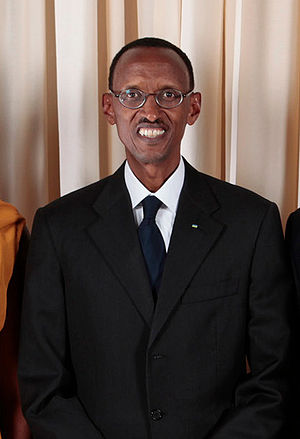 Image via Wikipedia Image via Wikipedia |
| The Man Who Kills Even a Fly with a Hammer |
International human rights groups, including Amnesty International, have concluded that Mr. Ntaganda was almost certainly targeted for his opposition to the regime of President Paul Kagame. President Kagame is not well known in the United States, but he owes his prominence to the role he played in ending the 1994 Rwandan genocide as leader of the Rwandan Patriotic Front, or RPF. The sanitized version of this story was distributed to American audiences briefly in the award winning film Hotel Rwanda. Unfortunately, the politcally correct version omits several important facts, omissions that help explain the current political climate in Rwanda and the slide toward authoritarianism on the part of Kagame and the rest of the political leadershipWriting for Foreign Policy magazine last August, former Democratic Senator Robert Krueger, who served as ambassador to Burundi, a neighbor of Rwanda with similar laws and ethnic divisions, offered some personal insight into Kagame that was far from flattering. He describes a man engaged in a retaliatory, politically-charged campaign of revenge against Rwandan Hutus. Indeed, the Rwandan genocide and subsequent RPF campaign would ultimately trigger the Second Congo War, an event with a staggering if still disputed death toll. Although he does not mention Clinton by name, the passing reference to the complicity of the United States speaks volumes.
Enter Peter Erlinder. After failing to prevent the genocide or to effectively manage the humanitarian and security crises that followed in its wake, the international community decided to prosecute those responsible. Security Council Resolution 955, passed in November of 1994, established the International Criminal Tribunal for Rwanda. China abstained, and Rwanda opposed the resolution as enacted. Nevertheless, the vote of the Security Council was final, and the ICTR was made manifest. Eventually, Erlinder would join the defense team.
As a defense attorney, he has been relatively successful. One of his more high profile clients, General Gratien Kabiligi, was acquitted of all charges two years ago, in a decision that infuriated the Kagame regime in Rwanda. His success has not been free of controversy. The emerging version of the Rwandan genocide brought out by the publication of the tribunal’s decisions as well as academics, witness accounts and the memoirs of Carla Del Ponte, the former chief prosecutor, conflicts with the prevailing narrative preferred in the United States, a version that first embraced by the Clinton administration in an effort to minimize its complicity with both the onset of the Tutsi mass murders and the retaliatory campaign waged by Kagame against Hutus and “traitorous” Tutsi. This transnational terror campaign helped provoke the Second Congo War, a mass ball of suffering that has snuffed out the lives of nearly six million Africans by some estimates.
An ICTR exhibit, a memorandum issued by George Moose to U.S. Secretary of State Warren Christopher, shows that the Clinton administration was aware of this retaliatory campaign by at least September of 1994:
ICTR Military-1 Exhibit, DNT 264, September 10, 1994 Memo from George Moose to Warren Christopher, U.S. Secretary of State: A UNCHR investigative team that spent July and August in Rwanda [i.e. Gersony] has reported systematic human rights abuses by the GOR (i.e. RPA/F) forces – including systematic killings – in the south and southeast of the country. The team has concluded that the GOR is aware of these reprisals against Hutu civilians and may have sanctioned them
On the basis of interviews with refugees/individuals, the UNCHR team concluded that a pattern of killing had emerged. The RPA convened meetings of displaced persons to discuss peace and security. Once the displaced persons were assembled, RPA soldiers moved in and killed them. In addition to these massacres, the RPA engaged in house to house sweeps and hunted down individuals hiding in camps. Victims were usually killed with hoes, axes, machetes and with fire. Although males 18-40 were at the highest risk the young and elderly were no spared. The team estimated that the RPA and Tutsi civilian surrogates had killed 10,000 or more Hutu civilians per month, with the RPA accounting for 95% of the killing.
The UNCHR team speculated that the purpose of the killing was a campaign of ethnic cleansing intended to clear areas in the south of Rwanda for Tutsi habitation. The killings also served to reduce the population of Hutu males and discouraged refugees from returning to claim their land.


No comments:
Post a Comment